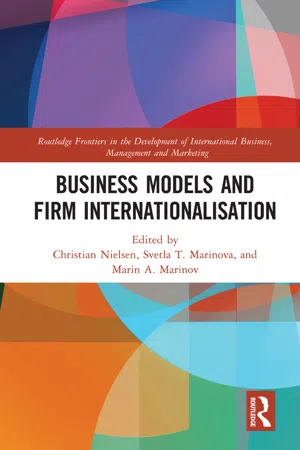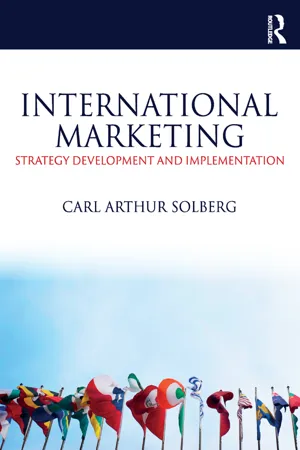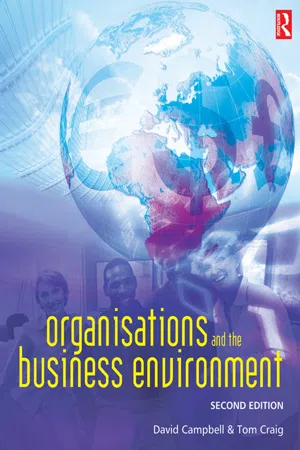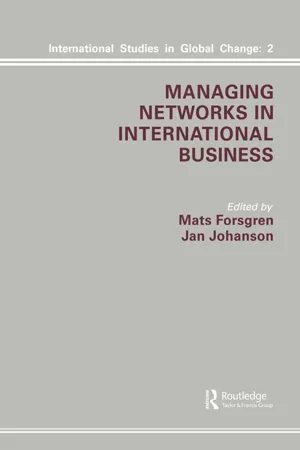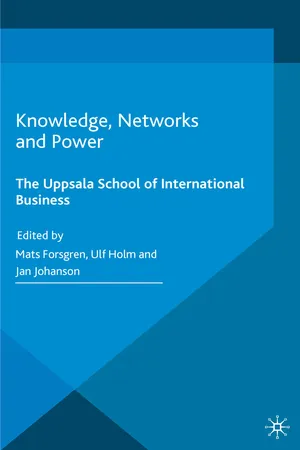Business
Internationalisation
Internationalisation refers to the process of expanding business operations beyond domestic borders to operate in international markets. This typically involves adapting products, services, and operations to suit the needs and preferences of diverse global customers. Internationalisation can also involve establishing partnerships, subsidiaries, or branches in foreign countries to facilitate market entry and growth.
Written by Perlego with AI-assistance
Related key terms
Related key terms
1 of 4
Related key terms
1 of 3
9 Key excerpts on "Internationalisation"
- eBook - ePub
- Christian Nielsen, Svetla T. Marinova, Marin A. Marinov, Christian Nielsen, Svetla T. Marinova, Marin A. Marinov(Authors)
- 2021(Publication Date)
- Routledge(Publisher)
The phenomenon has been researched intensively from a variety of viewpoints, including organisation theory, marketing, strategic management, international business, and entrepreneurship studies. This has resulted in an ambiguous perception of the term ‘ Internationalisation’ with no single accepted definition (Coviello & McAuley, 1999). Reid (1983) defines Internationalisation as a measure of the perceived difference between foreign markets and the home market space along economic, cultural, political, and market-strategic dimensions. Welch and Luostarinen (1988) have suggested a broad definition by including both inward and outward processes: “[…] the process of increasing involvement in international operations” (Welch & Luostarinen, 1988, p. 36). Calof and Beamish (1995) later defined Internationalisation as “the process of adapting firms’ operations (strategy, structure, resources, etc.) to international environments” (p. 116). More recently, Internationalisation has been associated with seeking and serving customers wherever they are in foreign markets (Gelbuda et al., 2014). Traditionally, Internationalisation through exporting has been considered as a way to increase the growth of firms (Kirby & Kaiser, 2003). Exporting is still significant, but during the last decade, firms have been focusing on different business activities as ways of Internationalisation and considering them to be important in achieving a competitive advantage. In general, firms can increase their involvement in international operations by following a single or a combination of equity and non-equity foreign entry modes (Kumar & Subramanian, 1997). The equity modes require major resource commitments; examples are joint ventures and wholly owned subsidiaries (through greenfield or brownfield investment, or full acquisition of a local firm) - No longer available |Learn more
International Marketing
Strategy development and implementation
- Carl Arthur Solberg(Author)
- 2017(Publication Date)
- Routledge(Publisher)
The middle of the grid denotes a situation full of potential both within the company and in the market. The company has “climbed” the Internationalisation ladder and management is characterised by a proactive stance towards further international involvement. The challenge for management in this case is to carve out a position in the markets where their key competitors have a stronghold. This will increase the company’s ability to react to competitive pressures in the event of a drive towards global markets. The expansion strategy that is selected will vary according to the specifics of the situation (for instance competitive structure, barriers to trade, demand pattern, etc.). Penetrating the home turf of key competitors, the company may wish to expand by inviting them to form strategic alliances, so as not to exacerbate the competitive situation. If the impeding factor is barriers to trade − for instance a closed distribution system (consumer goods with a handful of very powerful retail chains) − the company may again be advised to enter into some form of alliance with major players in the market, to buy a market share. Another way to get around the barriers is to enter into licensing agreements and joint ventures. The choice of one approach or the other will also vary according to the financial strength of the company. Exporting is still another possible entry approach, which may be feasible if the barriers and demand patterns do not constitute effective barriers to entry. In many ways, gradually increasing the company’s market presence through what one could term “controlled” exports is preferable because the company slowly but surely builds the international experience necessary to take on even bigger tasks in the future (Newbould et al. 1978); in this way the international organisational culture is allowed time to become embedded in the company (Solberg 1987, 1988).Window 6: Prepare for globalisation
The internationally mature company in a potentially global market is well-positioned to prepare itself for eventual shifts towards an even more global market. The analysis of the imminence and impact of the globalisation drivers is critical to companies in this window. To what extent, for instance, will the harmonisation of standards in the EU impact on industry structure? Will technological change alter the business model in the industry? Will our company’s reactions to developments bring about changes in the industry structure? - eBook - ePub
- Tom Craig, David Campbell(Authors)
- 2012(Publication Date)
- Routledge(Publisher)
subject to tariff charges or other restrictions. Payment of taxes to a host government by the importer has obvious implications for pricing whilst some goods are subject to limitations on the quantities imported. Such protectionist measures mean that exporters have many more factors to consider in exporting than if they were to restrict their activities to domestic business only.- The number of foreign interests that an exporter has means that the company must be aware of the business environments of more countries than just its own. Changes in the internal environment of a country with which the organisation does business can affect the performance of the company. An exporter has an interest in the political, economical and sociological environments of all of the countries it exports to. This significantly complicates the operation of an exporter’s business (although this can said to be a drawback of most entry strategies – not just exporting).
International Licensing and Franchising
Licensing and franchising across international borders, whilst being different in approach, both offer the same benefit: the gaining of international coverage and income with no direct investment.When we examined the concept of franchise in Chapter 5 , we saw that it was a way that a business with a transferable business idea can expand by renting the right to use the idea to a franchisee. Expansion by franchise is thus an expansion option which offers the franchisor the opportunity to gain income at little or no extra investment or risk to himself. Since moving to foreign markets inevitably contains an element of risk which may not be so marked if expansion were to be restricted to the domestic market, some companies have opted for international franchising as a means of Internationalisation. Franchising is a strategy that has been widely employed by some famous global brands such as KFC and McDonalds - Jay Mitra(Author)
- 2013(Publication Date)
- Routledge(Publisher)
A considerable amount of importance has been attached in recent years to the subject of globalization and internationalization as a stage for innovative growth, the emergence of ‘born global’ firms, and the ‘connected’ environment of network-based small and large firms developing new products and services collaboratively in a highly competitive market place. The global market place and the globalization process are the currency of our times. Successful business activity and entrepreneurship are assumed to be determined by global factors, where nation states and national boundaries appear to matter less than the larger global canvas (Ohmae, 1995; Cairncross, 1997). Technology, especially information and communications technology, is deemed to be largely responsible for such developments.We need to distinguish between ‘globalization’ and ‘internationalization’, not least because interchangeable use of terminology can be confusing. They do not, of course, mean the same thing, and the processes involved, their influence, impact and scope all have different connotations. We shall come to that later.More importantly, and long before the often emotionally charged debate of globalization acquired any prominence in both business meetings and dinner table conversation, the business of commerce and industry and the creation of new ventures have all had an international dimension to their modus operandi. What we do know is that businesses of all shapes and sizes operate in international markets and are affected by the internationalization process that brings foreign firms into competitive domestic markets. Intuitively, we tend to assume that larger firms are better equipped to operate in the international marketplace than smaller firms. Some of the literature tends to back that view because internationalization is a resource-intensive process requiring the experience and know-how that is acquired more easily by larger businesses. The reality can be somewhat different.We have noted elsewhere (Chapter 5- eBook - ePub
Strategic Consulting
Tools and methods for successful strategy missions
- Philippe Chereau, Pierre-Xavier Meschi(Authors)
- 2017(Publication Date)
- Palgrave Macmillan(Publisher)
strategy whose difficulties should not be underestimated.The first difficulty is knowing where the frontiers lie between local and international. Many companies with no direct international links access foreign markets indirectly through being referenced by globalised omnichannel or online distributors that sell these “local” suppliers ’ products in their foreign networks. Other companies with local B-to-B contracts manufacture and sell components to large groups that assemble, transform and sell the finished products internationally. But do the above examples illustrate companies operating on a purely local basis or companies that have begun to internationalise? In fact, many of these companies internationalise, without knowing or planning it. In other words, they are aware that they have embarked on a process of Internationalisation, but have not specifically organised for this. They adopt a reactive (not proactive) strategic attitude, seizing market opportunities as they come up. Finally, these companies are no longer truly local but not yet fully international and they do not reap all the potential benefits of a more thoughtful and deliberate approach to Internationalisation.A second difficulty comes from the paradoxical situation of foreign markets and customer behaviour in different parts of the world. For the uninitiated, the trends and characteristics of globalisation are disconcerting. It is as if two parallel worlds were simultaneously pulling in opposite directions. On one side, there is the world of globalisation where customer tastes, habits and behaviour are homogenising alongside converging modes of consumption. This is the borderless world described by Kenichi Ohmae (former consultant at McKinsey in Japan) in The Invisible Continent 2 or by Thomas L. Friedman, the New York Times journalist, in The World is Flat. 3 It is a world in which global brands like Apple, Samsung, Google, Facebook, Gucci and Louis Vuitton prosper by selling identical products, services and solutions throughout the whole planet. But beside this globalised “flat world,” another world exists. In this world, religion, ethnicity, claims for nationalism and sovereignty are exacerbated with local governments frequently intervening in the economic sphere. To use the terms of Pankaj Ghemawat , professor of international strategy at the IESE in Barcelona and New York University’s Stern School of Business, this is the world of “distance ,” the world of cultural, administrative, geographical and economic (or “CAGE ”) differences. The fault lines described by Ghemawat in a series of articles published in the Harvard Business Review run through both emerging and developed economies. In this fractured and compartmentalised world, “guarded globalization ”4 prevails. This makes it very difficult for foreign entrants to address not only customers, but also suppliers , distribution networks, State and government institutions, or indeed the entire society with global brands, identical products and solutions and standardised approaches to communication and distribution. This paradoxical co-existence makes Ghemawat say that we have entered an age of semi-globalisation, the age of “World 3.0 ” to quote the title of his latest book.5 The difficulty of internationalising causes for companies is how to manage this paradoxical situation and this world of distance. Should companies adapt to this distance? Should they try to reduce it? Or should they take advantage of it by disaggregating their value chain regionally and adopting a specific international organisation - Marin Alexandrov Marinov(Author)
- 2018(Publication Date)
- Routledge(Publisher)
The internationalization process has facilitated the overall economic globalization (Ohmae, 1992 ; Sassen, 1996). This exercises a positive impact on the scope and intensity of international competition. Internationalization of business brings benefits to firms and regions where it takes place. The growing pace of internationalization has occurred within the boundaries of regional economic integrations, national economies, economic sectors and individual businesses. It can be argued that through the internationalization of production and markets the world is moving away from an economic system in which national markets are distinct entities with certain degrees of isolation from each other by barriers of different nature towards a system in which national markets are merging into a global marketplace. Hence, a most notable characteristic of current economic integration is the process in which regions, countries, and companies have become increasingly interdependent, representing intrinsic parts of the world economy (Auerbach, 1996). Brief Outlook on Internationalization Theory The foundations of the internationalization theory were laid down by Coase (1937). He introduced the notion that there may be conditions under which a firm may find it more efficient to create an internal market rather than enter foreign markets. Those conditions are identified as transaction costs of foreign activities. Williamson (1975) developed the internalization perspective that coupled with the transaction cost theoretical approach emphasized the minimization of transaction costs and the conditions underlying market failure. When adopting the internalization perspective, a firm considering internationalization is faced with the dilemma of either internalizing within its own boundaries (a subsidiary) or forming a collaborative venture with an external partner (externalization)- eBook - ePub
- M. Forsgren, J. Johanson(Authors)
- 2014(Publication Date)
- Routledge(Publisher)
Empirical studies at Uppsala about this choice indicate that both management and research problems should be framed somewhat differently and be more directed to the internationalization process whereby firms gradually commit themselves to and learn about foreign markets and operations (Carlson, 1966, Hörnell & Vahlne, 1973, Johanson & Wiedersheim-Paul, 1975, Forsgren & Johanson, 1975, Johanson & Vahlne, 1977). The basic conclusion of these studies is that a firm’s internationalization is a gradual process which in turn is the result of an interplay between two separate, but closely related processes; knowledge development processes and commitment processes. International expansion is inhibited by the lack of knowledge about foreign markets and such knowledge can mainly be acquired gradually through experience from practical operations abroad. New opportunities and new problems in the foreign markets are discovered as a consequence of operations. Thus internationalization is a gradual process where the firm stepwise expands and defends its foreign operations.The internationalization of the firm is in this approach a growth process. Because of lack of resources and knowledge about foreign environments the firm first develops its home market operations. Because of internal factors, e.g a need to expand the operations in order to be more profitable, or a surplus of resources that must be used, the firm eventually starts to export. But the first export order can also appear as a consequence of initiative from the market side. Companies abroad ask for offers or give orders directly or through middlemen. A combination of internal and external factors may be the most probable explanation.Irrespective of the reason for the export start it is rather limited in the beginning. It represents a small part of the firm’s turnover, is confined to a few countries and does not imply any major investments there. It can rather be seen as a way to explore other markets than the home market. Usually an independent agent represents the firm abroad. The limited financial and personal resources in combination with uncertainty about foreign affairs impel the firm to avoid undue engagement in the international operations.Some of the markets abroad for the firm’s products will eventually grow, and the knowledge thereof will increase through the experience from the exporting activities. In consequence the possibilities of larger engagements in certain markets will increase. At the same time the need to control the export activities in the larger markets will increase and problems or crises with the representatives, for example, will induce the firm to take over the agents and establish sales companies of its own.Through its own sales subsidiaries the firm becomes acquainted with foreign markets and is in a better position to evaluate the selling possibilities and the need for market investment. The foreign organization is enlarged in order to support the marketing activities by stock-holding, spare part, and repair services and, eventually, production of certain components. - eBook - ePub
International Marketing
Strategy and Theory
- Sak Onkvisit, John Shaw(Authors)
- 2009(Publication Date)
- Routledge(Publisher)
Sony Corp. provides a good illustration of the nature of international marketing in terms of both the challenges and opportunities. Both the international and local conditions must be taken into account. This chapter addresses the who, what, why, and how of international marketing by giving an overview of the nature of international business. The discussion begins with an examination of how marketing in general is defined and how that definition works for international marketing. The chapter examines the criteria that determine when a company has successfully transformed itself into a multinational firm. To dispel some popularly held misconceptions, there is an explicit treatment of the benefits of international trade.Process of international marketing
A study of international marketing should begin with an understanding of what marketing is and how it operates in an international context. International marketing is the multinational process of planning and executing the marketing mix (product, place or distribution, promotion, and price) to create exchanges that satisfy individual and organizational objectives. The word “multinational” implies that marketing activities are undertaken in several countries and that such activities should somehow be coordinated across nations.This definition is not completely free of limitations. By placing individual objectives at one end of the definition and organizational objectives at the other, the definition stresses a relationship between a consumer and an organization. In effect, it fails to do justice to the significance of business-to-business (B2B) marketing, which involves a transaction between two organizations. In the world of international marketing, governments, quasi-government agencies, and profit-seeking and nonprofit entities are frequently buyers. Companies such as Boeing and Bechtel, for example, have nothing to do with consumer products. Likewise, Russia’s export agency, Rosoboronexport, represents the country’s 1700 defense plants and sells arms to governments all over the world.Nonetheless, the definition does offer several advantages by carefully describing the essential characteristics of international marketing. First, what is to be exchanged is not restricted to tangible products (goods) but may include concepts and services as well. When the United Nations promotes such concepts as birth control and breast-feeding, this should be viewed as international marketing. - eBook - ePub
Knowledge, Networks and Power
The Uppsala School of International Business
- U. Holm, M. Forsgren, J. Johanson, U. Holm, M. Forsgren, J. Johanson(Authors)
- 2015(Publication Date)
- Palgrave Macmillan(Publisher)
In light of all of this, we have developed our revised model in the following way. The firm is embedded in an enabling, and at the same time constraining, business network that includes actors engaged in a wide variety of interdependent relationships. Internationalization is seen as the outcome of firm actions to strengthen network positions by what is traditionally referred to as improving or protecting their position in the market. As networks are borderless, the distinction between entry and expansion in the foreign market is less relevant, given the network context of the revised model. The traditional view of entry – that is, overcoming various barriers – is becoming less important than internationalizing undertaken to strengthen a firm’s position in the network (Johanson & Vahlne, 2003). As a result, we claim that existing business relationships, because they make it possible to identify and exploit opportunities, have a considerable impact on the particular geographical market a firm will decide to enter, and on which mode to use. This claim is also consistent with the business network view, where much is contingent on existing relationships (Håkansson & Snehota, 1995). Learning and commitment building take place in relationships. Although our 2003 article did not highlight that particular point, this way of thinking about internationalization places the identification of opportunities at the forefront. While we mention in our 1977 article that experiential knowledge may lead to the identification of opportunities, this aspect has largely been neglected. Primarily, it has been assumed that reducing uncertainty has to do with the differences between the culture and institutions of the home country and those of the foreign country. We now have reason to believe that learning and commitment are strongly related to identifying and exploiting opportunities (Johanson & Vahlne, 2006). As some types of knowledge are not accessible to everyone, and are instead confined to network insiders, a strong commitment to partners allows firms to build on their respective bodies of knowledge, making it possible for them to discover and/or create opportunities. We believe that internationalization is contingent more on developing opportunities than on overcoming uncertainties, for example concerning institutional conditions in the foreign market (Eriksson et al., 1997).
Index pages curate the most relevant extracts from our library of academic textbooks. They’ve been created using an in-house natural language model (NLM), each adding context and meaning to key research topics.
Explore more topic indexes
Explore more topic indexes
1 of 6
Explore more topic indexes
1 of 4
